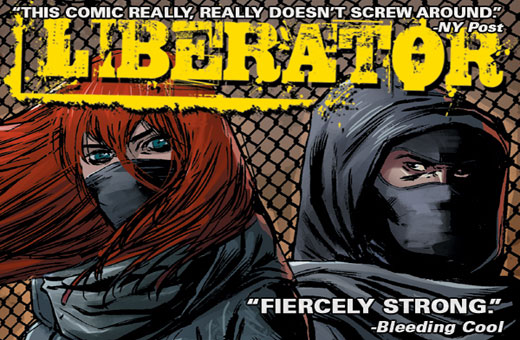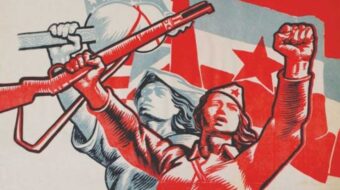
A new comic book mini-series hit the shelves recently with an important message for readers of all ages: Liberator Comics. It is a bold new voice speaking out against animal mistreatment and abuse. The first two issues have been a hot title not only for collectors, but for everyone who supports humane treatment of all animal species.
The comic book presents a stunningly powerful storyline involving animal rescuers. It also provides valuable information concerning the plight of animals involved in laboratory research and corporate farms.
The publisher of Liberator Comics, Black Mask Studios, has quite an interesting history. The company was originally formed as a new independent distributor when Matt Pizzolo, Steve Niles, and Brett Gurewitz wanted to chronicle the Occupy Wall Street movement, while donating profits to the cause (Occupy Comics). Black Mask is now an outlet for artists who seek greater creative freedom, while boldly confronting relevant, political issues. Kickstarter, an online source that provides funds for projects through individual donations, was instrumental in helping Liberator Comics become a reality.
The comic series confronts animal abuse in all forms, including by individuals, corporations, and alarmingly, public universities, and research facilities. One common denominator definitely perpetuates the harmful and painful treatment of these unfortunate creatures: money. The series help bring to light the reality of taxpayer money contributing to the senseless torture of helpless animals in university laboratories.
Readers will learn that much research data obtained through harmful animal experiments ultimately has minimal or no value. The sad fact is, the main reason these abuses continue is the steady flow of grant money. Institutions do not want to lose public funds they have already budgeted, so they continue using live animals in many non-essential tests.
The continuing storyline chronicles the efforts of two liberators who take drastic measures to rescue creatures suffering in various facilities under cruel conditions. Although the graphic story is fictional, it is intended to echo actual events. The protagonists in Liberator Comics are determined never to harm any human beings on their quest to free abused animals. However, the comic book portrays tactics used by animal liberators over the years that have not always been legal. It is up to individual readers to ponder when or if a line should be crossed to stop the unnecessary suffering of animals. Regardless, some new light is being shed on a moral issue that is too often swept far away from the spotlight.
One of the variant artwork covers featured on Liberator Comics #1 depicts the “Ag-Gag” laws that have been enacted in various states. These are laws that make it a crime for whistleblowers to obtain photographic evidence of cruel animal treatment at agricultural or research facilities without the permission of the operators. In essence, these laws make criminals of concerned citizens who seek to gather evidence of substandard conditions in facilities such as large corporate factory farms. The public often receives little or no information about closed-door abusive practices. The old saying “out of sight, out of mind” certainly applies here, as many of these creatures suffer without ever seeing the light of day.
The publication also features informative articles designed to educate readers. “Life in The Lab: What’s The Cost?” by Shannon Keith in Liberator Comics #2 explains how an endless array of animals are forced to ingest, or are exposed to, countless toxins. Although animal testing is often unreliable, their lives are continually sacrificed for the sake of testing cosmetics, beverages, pharmaceuticals, and household cleaners. The facts are shocking. According to 2010 U.S. government statistics, approximately 65,000 dogs alone are being used in tests. These dogs are bred by large commercial breeders for use in labs, and many spend their entire lives in isolated concrete enclosures. The Animal Welfare Act only provides very limited protective standards for experiments.
The subject matter of Liberator Comics is extreme and intense for a very good reason. It seeks to inform readers in a graphic manner about a subject that is often relegated to the back pages of the news. Corporate profits and university grant money are the main reasons why these animals continue to suffer, and thankfully Liberator Comics helps to expose this appalling fact.
The creator and writer of Liberator Comics, Matt Miner, is a longtime crusader against animal cruelty. This is his initial venture into the world of comic books, and he says 30 percent of profits will go to animal rescue initiatives. Pencils and inks are by Javier Sanchez Aranda. Colors are by Joaquin Pereyra. The books are lettered and edited by Vito Delsante.
Photo: Liberator official site

MOST POPULAR TODAY

‘Warning! This product supports genocide’: Michigan group aims to educate consumers

Ohio: Franklin County treasurer attends Netanyahu meeting, steps up Israel Bond purchases

“Trail of Tears Walk” commemorates Native Americans’ forced removal

After months of denial, U.S. admits to running Ukraine biolabs

Hold the communism, please: SFMOMA’s Diego Rivera exhibit downplays artist’s radical politics






Comments